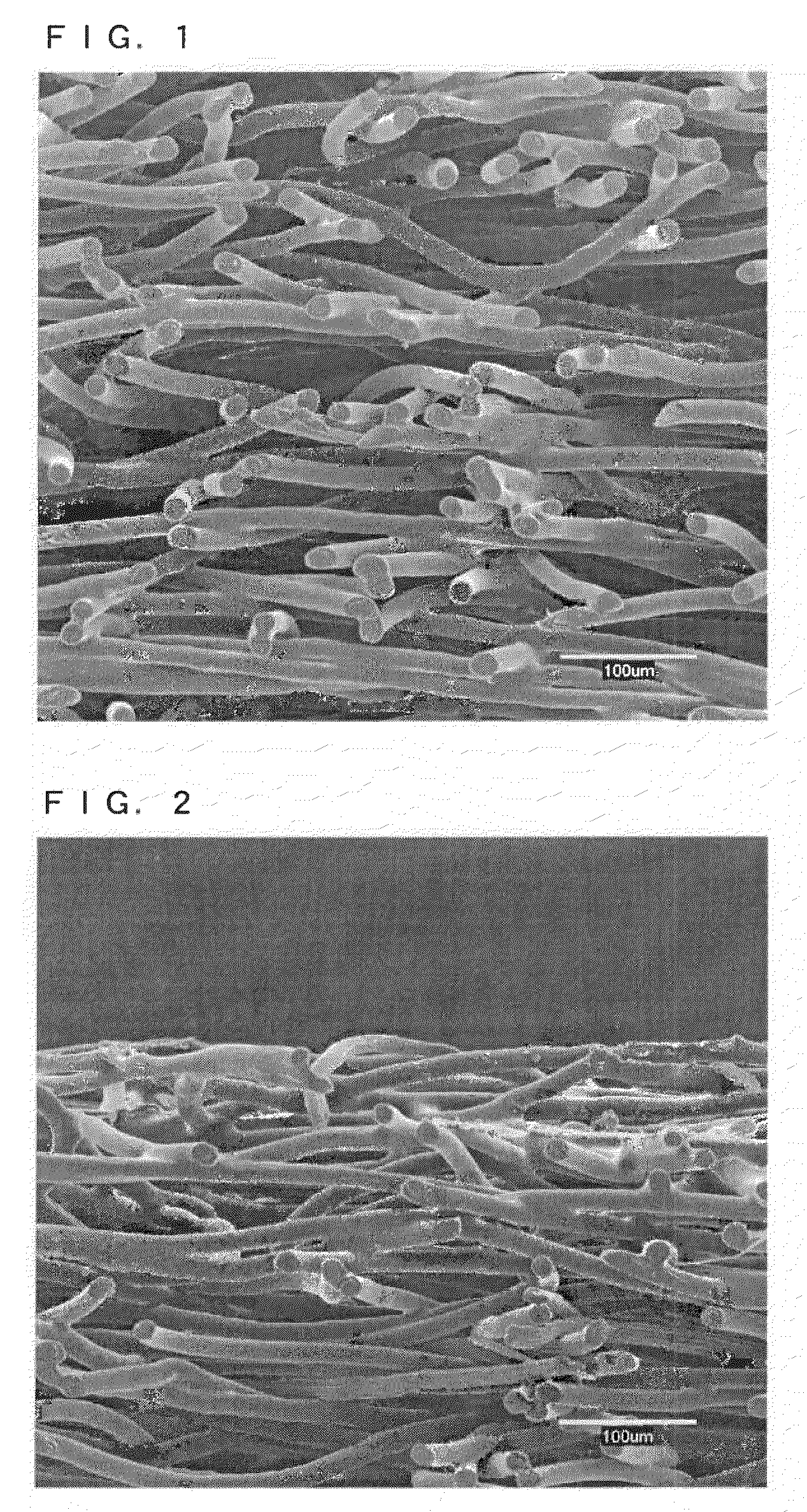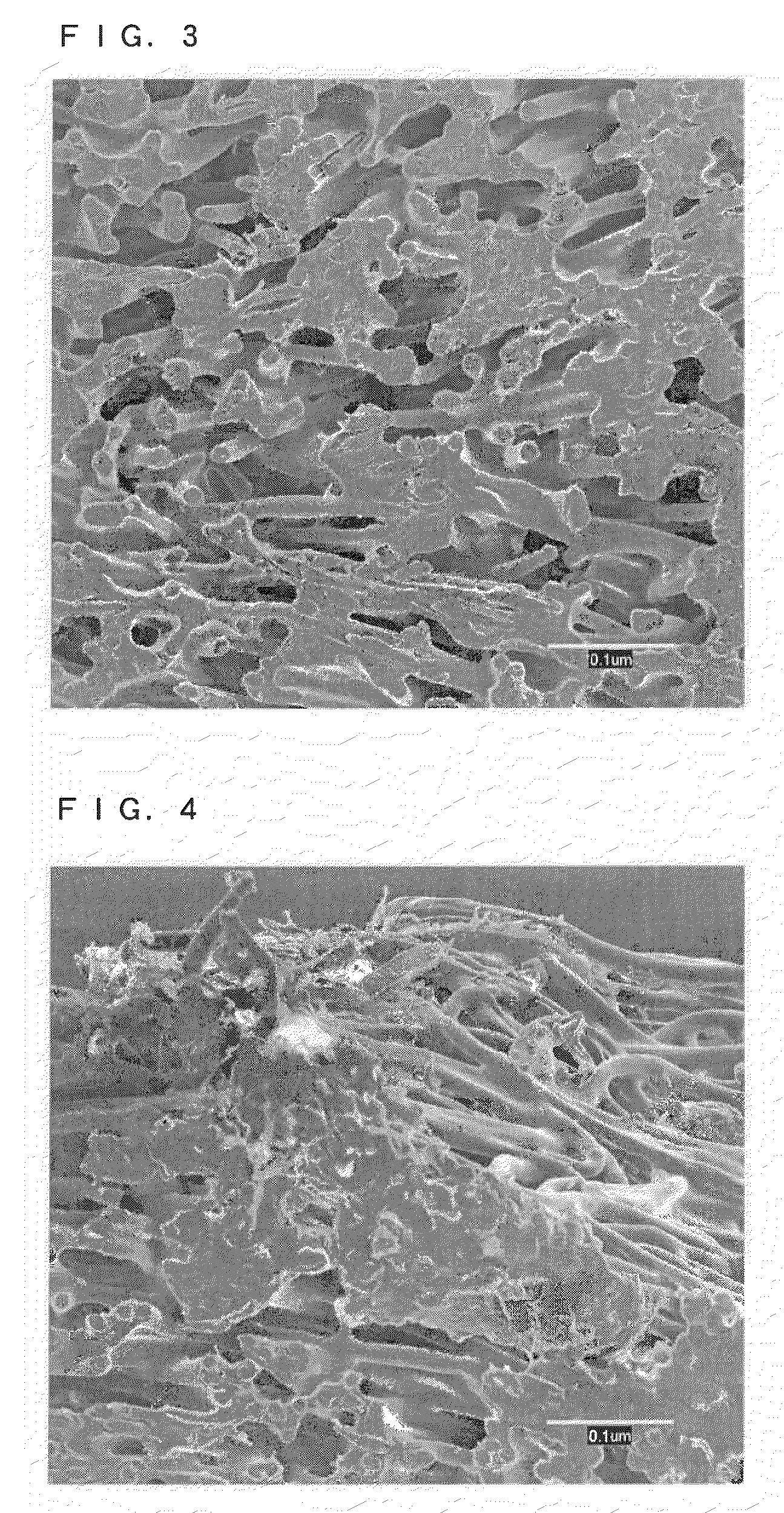Molded object having nonwoven fibrous structure
a nonwoven fabric and molded object technology, applied in the field of shaped products, can solve the problems of difficult to produce nonwoven fabrics having an adequate hardness, and excessive heating of nonwoven fabrics, etc., to achieve high hardness, low density, and high bending stress
- Summary
- Abstract
- Description
- Claims
- Application Information
AI Technical Summary
Benefits of technology
Problems solved by technology
Method used
Image
Examples
example 1
[0145]A sheath-core form conjugated staple fiber (“Sofista” manufactured by Kuraray Co., Ltd., having a fineness of 3 dtex, a fiber length of 51 mm, a mass ratio of the sheath relative to the core of 50 / 50, a number of crimps of 21 / inch, and a degree of crimp of 13.5%) was prepared as a thermal adhesive fiber under moisture. The core component of the conjugated staple fiber comprised a polyethylene terephthalate and the sheath component of the conjugated staple fiber comprised an ethylene-vinyl alcohol copolymer (the content of ethylene was 44 mol % and the degree of saponification was 98.4 mol %). Using the sheath-core form conjugated staple fiber, a card web having a basis weight of about 100 g / m2 was prepared by a carding process. Then seven sheets of the webs were laid on another to obtain a card was having a basis weight of 700 g / m2 in total. The obtained card web was carried onto a 50-mesh stainless steel endless net having a width of 500 mm.
[0146]Incidentally, the belt convey...
example 2
[0152]Except that 70 parts of the thermal adhesive fiber under moisture used in Example 1 was blended to mixed with 30 parts of a rayon fiber (having a fineness of 1.4 dtex and a fiber length of 44 mm) to produce a card web having a basis weight of about 100 g / m2 and seven sheets of the obtained card webs were laid on another to be subjected to the vapor treatment, using the same manner as in Example 1 the shaped product of the present invention was obtained. The results are shown in Tables 1 and 2. The obtained shaped product also had a board-like shape. Although the shaped product was slightly soft compared with the shaped product obtained in Example 1, the bending behavior of the shaped product was similar to that of the shaped product obtained in Example 1. In addition, in the shape retention property test, although a slight fall off of the fibers was observed, the decrease in mass was about 1%.
example 3
[0153]Except that 50 parts of the thermal adhesive fiber under moisture used in Example 1 was blended or mixed with 30 parts of a rayon fiber used in Example 2 to produce a card web having a basis weight of about 100 g / m2 and seven sheets of the obtained card webs were laid on another to be subjected to the vapor treatment, using the same manner as in Example 1 the shaped product of the present invention was obtained. The results are shown in Tables 1 and 2. The obtained shaped product also had a board-like shape. Although the shaped product was softer than the shaped product obtained in Example 2, the bending behavior of the shaped product was similar to that of the shaped product obtained in Example 2. In addition, in the shape retention property test, although a slight fall off of the fibers was observed, the decrease in mass was about 4%.
PUM
| Property | Measurement | Unit |
|---|---|---|
| Fraction | aaaaa | aaaaa |
| Fraction | aaaaa | aaaaa |
| Fraction | aaaaa | aaaaa |
Abstract
Description
Claims
Application Information
 Login to View More
Login to View More - R&D
- Intellectual Property
- Life Sciences
- Materials
- Tech Scout
- Unparalleled Data Quality
- Higher Quality Content
- 60% Fewer Hallucinations
Browse by: Latest US Patents, China's latest patents, Technical Efficacy Thesaurus, Application Domain, Technology Topic, Popular Technical Reports.
© 2025 PatSnap. All rights reserved.Legal|Privacy policy|Modern Slavery Act Transparency Statement|Sitemap|About US| Contact US: help@patsnap.com



